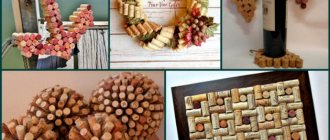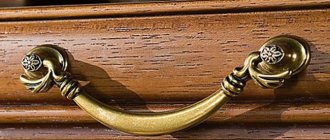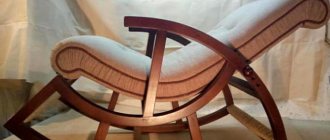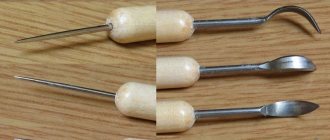Many knife makers tend to try to make different versions of blades and handles. Looking for the most suitable method for yourself, and practice will not be superfluous. An original and interesting way to make a knife handle from champagne corks. If the champagne is of high quality, it is corked with real cork.
A knife with a handle made of cork.
Useful knowledge about traffic jams
Wine and cognac drinks are sealed with real cork products. They do not react with the drink and do not spoil the taste. The cork known to us today appeared relatively recently - in the 17th century. It is made from oak, which grows in some European countries.
It is so whimsical that its habitats are quite small. The largest number of trees is in Portugal. Cork oak bark is removed in a special season, and only from trees that are over 25 years old. It is removed in small sections to avoid harm to the plant.
Cork fishing is a whole industry that involves many people and modern equipment.
DIY knife handle made from wine corks
A blade with a balsa wood handle is called a floating knife. The handle must be made to calculate the buoyancy of the product when it gets into the water. A knife with such properties is popular among fishermen. Only experience will allow you to achieve buoyancy.
For the appropriate type of handle, we recommend a wedge no longer than 11 cm, a butt no thicker than 1.5-2 mm and a width no more than 2 cm. Increasing the thickness or length of the blade automatically leads to an increase in the handle in the same directions. The product will look awkward and ridiculously funny.
Before making a knife handle from champagne corks, consider these parameters. If the situation is stalemate, try blade reconstruction. Shorten it a little, if the design allows, cut out the valleys or grind off the butt. But the barrel-shaped handle is clearly inconvenient and unpresentable.
Homemade cork handle for a knife
Champagne corks look irregular in shape after uncorking. This can be easily fixed by putting them in the microwave for 30 seconds. Having acquired an even cylindrical shape, we send them to work. To obtain one element of a inlaid cork handle, you need to perform several manipulations:
- Taking two corks, carefully cut off a small piece lengthwise from each of them. Smooth out the cuts with sandpaper.
- Having coated the cut with glue, firmly glue them to each other.
- After drying from a single workpiece, it is necessary to cut off two pieces again with a longitudinal cut. You will get a rectangular shape.
- A hole is made in the center for mounting on the shank.
The number of such rectangles depends on the length of the shank. The bolster and pommel must be made of wood. When forming the handle, the cork will be greatly deformed on the metal parts.
Having made the bolster and the required number of rectangles, the handle is ready for assembly. It must be assembled like a regular handle. Putting the parts on the shank one by one, coating everything with epoxy resin. Having collected, we send it to the press.
After drying for 24 hours, we bring the handle to the desired oval shape. Sand with sandpaper. And you can soak it with varnish, well diluted with acetone. The process must be carried out by repeated dipping into liquid. Then leave until completely dry.
We make a “poacher’s” donk from cork
“Cork” is designed for catching mainly large fish, such as carp, bream, large roach, rudd. However, you can adapt to catching smaller fish by experimenting with the size of the hooks and the diameter of the fishing line.
According to the author, this gear is very effective and allows you to be with the fish even on days when most fishermen don’t bite. According to him, bites begin to follow almost within a couple of minutes. Of course, a lot also depends on the place of fishing.
Tools and materials for manufacturing: – 1 aluminum and 1 PET bottle cap; - lead; – fishing line for creating leashes and hooks (4-10 number according to the old standard); – nylon thread and clamp for attaching leashes; – a piece of copper wire; – awl, scissors; – bait (if already fishing).
Let's move on to the manufacturing process
Step 1. Create a sinker
You need to take an aluminum plug and use an awl to pierce two holes in it as in the picture; exactly the same holes need to be made in the PET plug. Next, a copper wire is inserted into the aluminum plug; it will connect the two plugs together. Then you need to melt lead or tin and pour the metal into the aluminum plug so that it does not reach the top turn of the plug. If a cork from Baltika No. 3 is used, the PET cork will be able to fit into its upper turn and the design will be of better quality.
Step 3. Prepare the tackle for casting
Before sending the tackle to the bottom, you need to put bait in it and install the hooks correctly. As food, the author uses ordinary bait for catching carp or bream, which can be bought at a fishing store. And in an even more conservative version, you can prepare the bait yourself.
Handles for frying pan lids
Has your frying pan served you faithfully for years? This would have continued if the pen had not literally started to crumble in your hands. Now you are forced to look for a replacement. Manufacturers of kitchen utensils often include replacement fittings in their product range. Buying a handle for a frying pan lid is as easy as buying the frying pan itself. In the Cylinder online store it is easy to choose an accessory for a glass or colored frying pan lid.
Replacing round and oval handles
It's hard to imagine the cooking process without a lid. Water in a covered pan boils much faster, and in a closed frying pan food and meat are stewed until fully cooked over low heat.
Lids for frying pans are made of different materials: glass, metal, silicone, ceramics. But mainly it is heat-resistant glass and aluminum. They are easy to care for and light in weight. The glass lid with a handle for the frying pan is especially convenient - you can visually control the entire frying process and, if something happens, prevent burning.
The handle is an element that must be present on the lid. It will allow you to carefully open the pan during cooking without harming yourself. So, if the handle has come unglued from the glass lid of a frying pan or saucepan, it must certainly be replaced. Ergonomics is an equally important parameter. An oval or round handle for a frying pan lid, which the Cylinder website offers to buy, fits more comfortably in your hand.
Round handles from the lids of pots, pans, and stewpans are the most vulnerable component of a set of dishes. This is due to frequent, prolonged and incorrect heating, which gradually renders the fittings unusable. Experienced housewives have probably encountered a situation in their lives when, due to flying off fittings, they had to completely change an accessory. Who doesn’t know, there is an easier and more economical way - just buy a handle for the frying pan lid.
A round or oval handle for a glass frying pan lid, which you can easily buy at a hardware store, will not cause any problems with selection, due to its simple design.
Depending on the type of attachment to the lid, the fittings are:
- Cast – melted together with the product. Heats up quickly, so additionally requires an oven mitt
- Soldered - considered more reliable
- Screwed down with screws – it doesn’t look so attractive visually. On the back of the lid you can see fastenings on which grease accumulates. It's hard to wash them off.
Accessories material and service life
The service life of accessories also depends on the material from which they are made.
- Metal – aluminum, steel, cast iron. Their strength is beyond doubt. But metal, as you know, heats up quickly. Therefore, the fittings actually tolerate the same temperature as the frying pan. Do not rush to grab the lid handle with your bare hands, otherwise you risk getting burned. It is better to arm yourself with a thick potholder for this case. The advantages of the handles include fire safety: they heat up, but do not ignite like, for example, plastic
- Bakelite is a type of plastic, but it is superior in quality. Due to this, it is widely used in the manufacture of tableware. Heat-resistant plastic does not heat up, or rather the maximum temperature is 150 ° C, and for some manufacturers up to 260 degrees. The handles have low thermal conductivity, which means you can handle them with bare hands in a hot frying pan. Even if bakelite handles get too hot, they will not ignite. There will only be an unpleasant smell of burnt plastic in the air. Due to severe overheating, their shape may become deformed, the surface will become rough and unpleasant to the touch.
Source
Fishing rod for winter - a practical guide to making it yourself
Winter fishing is somewhat different from summer fishing. This type of fishing begins when the first, fairly strong layer of ice appears. You can read about how to find out the thickness of ice in our other article.
Since there is no need for long casting, you don’t need a long fishing rod . On average, the length of fishing rods for summer fishing ranges around three meters, while winter fishing rods, on the contrary, are a small piece of material suitable for the fishing rod, on one side of which there is a comfortable handle, and on the other, a flexible tip. The length of such a fishing rod is 30-50 centimeters .
Fishing rods for winter fishing can be divided into several types:
- Float fishing rods - such fishing rods are no different in the principle of fishing from summer ones. Floats are also used to detect bites.
- Floatless – these fishing rods do not have a float and are designed for jig fishing.
- Using a spinner or a balancer – these fishing rods are used for catching predatory fish.
In this article we will take a closer look at what types of fishing rods there are , which one to choose, and also tell you how you can make a fishing rod for winter fishing with your own hands .
Repair of the gas control knob.
Quite often, handles fall out on many gas stoves.
And as a rule, the locking plates are lost, which prevent idle cranking when the burner is ignited. These spring plates are not easy to find. To get out of this situation, instead of a plate, I used a regular clip from the cap of a stationery ballpoint pen. In many pens this clamp is made of decent spring steel. In short, I cut off a fragment with a hacksaw and inserted it. The handle does not turn at idle, i.e. works as it should. Another example.
Features of choice
For fishing it is very important to choose the right specimen, and for winter fishing this is especially important. First of all, you should decide what kind of fish the fishing rod is selected for; then it is important to pay attention to such parameters as lightness, convenience and functionality . The design should not malfunction during fishing, so you should not use a plastic whip, because it may burst. A good choice would be a carbon fiber model that is equipped with a reel with an open lock.
Nowadays, specialized fishing stores have a large selection of different fishing rods and tackle, but there are a number of reasons why a fisherman might want to make a fishing rod at home, for example:
- cost savings;
- the fisherman is a big fan of tinkering and can make everything himself;
- I didn’t like anything in the store;
- There is no store nearby at all (relevant for villages).
It is important to know! Making a winter pike-perch fishing rod yourself is not as difficult as it might seem at first glance, and the materials and tools that may be needed are often in the arsenal of a DIYer, so there is no need to purchase anything separately.
DIY frying pan handle
Hello to all visitors to the “Secrets of the Master” site! I immediately apologize for the violation of the frequency of publication of articles. The increasing construction season is taking its toll. Nevertheless, I sprinkled in a little. In this article we will work for ourselves, namely, we will do household chores. I bring to your attention a few examples. Maybe it will be useful to someone.
- Remaking curtain rods.
- Remaking a broken pot lid handle.
- Replacing the front glass on the oven door of a Nord gas stove.
- Repair of the gas control knob of the same stove.
- Reworking the broken handle of the mosquito net frame.
Float
This fishing rod is also suitable for winter fishing; the main feature is that it does not need to be held in your hands. It is installed on a special stand near the hole. You can display several fishing rods at once. All that is required from the fisherman is to monitor the bite and ensure that the holes do not freeze.
Making such a fishing rod with your own hands will not be difficult; all you need is to make a float. A champagne or wine cork or a piece of polystyrene foam is ideal as a material. The length of the product should vary within 3 cm, and the width 5-6 cm. It is recommended to paint it in a bright color. It does not require a reel, since the equipment is wound directly onto the base of the fishing rod, but you should not neglect the sinker.
You can also make a winter fishing rod for crucian carp with your own hands. You can use a small plastic tube to make the handle. Let's look at the manufacturing process step by step:
- You should cut a small piece from the tube, about 15 cm , less or more. It will be convenient for anyone.
- You can attach either a reel or multiple staples to the front.
- The handle should be insulated ; for this you can use any available material, for example, polystyrene foam.
- The ends should be sealed with stoppers. Don't forget to add weight.
- You must first make a hole in the front plug for the whip.
- Next you need to insert the whip into the hole and secure it.
- Afterwards the legs are made; for this you can use cork, plastic, and so on.
Making a handle for a pot lid
The first thing to do is to drill holes strictly in the center of the covers; this is quite easy to do, since the covers initially have marks on them from the factory.
Further. When everything is ready, insert the bolt inside.
Then we put on the washer and twist the two lids together using a nut, clamping it with pliers.
Now we take the handle and install the protruding part of the bolt into the hole in the cover, but before that we put a washer on the bolt.
Then we put on the washer but on the other side and tighten it with a nut.
That's basically it. Let's see what we got!
I’ll add on my own that it actually took no more than 5 minutes to make such a homemade pen. The material chosen was very common, so that anyone can make such a pen. And one more piece of advice for those who want to repeat this work - it’s better to use lids that are not flat, but ones that are slightly concave inward, they don’t slide as much, and it’s more convenient to grab them with your hands. Well, if desired, for better structural integrity, the connection of the lids can be glued together with glue.
Source
Mormuscular
Using such a model, you will need to hold it in your hands throughout the entire fishing. Therefore, it should be compact, light and convenient, but also not lose its functionality. Let's look at two interesting options for fishing rods for jig fishing. This is a reelless jig for use with jigs.
The reelless rod is a lightweight, convenient fishing rod. For production you will need the following materials: a wine or champagne cork, as an alternative, a piece of dense foam, any rod (an umbrella needle, etc.), a set of cambrics, an x-ray, glue and markers.
The manufacturing process is very simple:
It is important to know! The whip can be attached both from the end and from the side. But in the second case, it will be more convenient to fish for larger fish, since this ensures the release of turns of the line.
For an attachment-mounted jig , this model is already more voluminous when compared with a reelless jig. The handle is made from foam, wood or cork and cut into a staple shape. A groove is cut in the handle for winding fishing line. In the front part, as usual, a hole is drilled for the whip. You can make it yourself, using, for example, a twig or a broken handle. The nod can also be made from a metal spring, an x-ray, or a plastic bottle. The nod holder is made from cambrics. You can also make a no-kick winter fishing rod with your own hands.
How to remake a curtain rod.
For example, there was a wall cornice, i.e. was mounted on the wall, and after a little modification it will be mounted on the ceiling.
For work we only need
- drill with a set of drills
- and a puncher for attaching the finished cornice to the ceiling.
First we remove the mounting brackets.
Then we drill holes ø4-6 mm with an even distance from each other, depending on the length of the cornice itself. Advice. ✔The recommended distance between holes should be at least 500 mm and the distance from the edges of the cornice should be 50-100 mm. ✔You need to mount it on the ceiling, stepping back from the wall at least 100 mm if the curtains are long and at least 50 mm if the curtains are short.
On a spinner or balancer
Predatory fish are caught with such baits, and, as you know, predators are found in the depths. Therefore, in the manufacture of such a fishing rod, special attention should be paid to the supply of fishing line . Also, such fishing rods are necessarily equipped with a reel. It is not possible to make a coil at home, so you will have to purchase it in a store.
Let's look at how to make a winter fishing rod for pike perch with your own hands. It is important to pay attention to the handle. It can also be made from a tube, but you will definitely need to insulate it. What is needed for this:
- Chop the wine cork into small pieces.
- Coat the tube with glue, leaving only the space for the coil.
- Roll it over the crumbs, wait until it dries and repeat the procedure./li>
- Having reached the required thickness, the handle should be treated with sandpapers of different grain sizes.
- When the handle is completely ready, you need to install the reel on it. To do this, you need to attach a reel seat to the handle; several clamps are suitable, between which the legs are clamped. You can also tape electrical tape on top.
Next, you should make and install the whip. The last section of the telescopic fishing rod will do. As usual, a hole is made in the handle into which a whip is inserted and attached. Please note that the length of the whip should be about 70 centimeters .
Passage rings (at least 3 pieces) are attached to the whip. For fastening you can use glue, fishing varnish and thread. The final stage of making a homemade winter fishing rod will be strengthening the nod, but many do not see the point in this and skip this stage.
Step-by-step instruction
If you have time, opportunity and most importantly, desire, you can do it yourself. The easiest way to make a handle for a frying pan is from wood, for example, birch, hornbeam, dogwood, maple. The algorithm of actions is as follows:
- We select a pin with a diameter that matches the bracket remaining after removing the broken handle. It can be purchased at any hardware store.
- We screw the pin into the bracket so that it does not rotate. To do this, drill a hole and secure it with a suitable nail.
- At a distance of 5 cm, bend the pin at an angle of 30 degrees. This is necessary for ease of use and to ensure that the handle does not burn.
- We cut 6 cm from the aluminum pipe, while cutting one side at an angle of 30 degrees.
- We drill a longitudinal hole for the pin in the wooden holder and also cut one of the sides at an angle of 30 degrees.
- We put a handle and bushing on the hairpin.
- We cut the stud so that there is a tail for the nut.
Now you know how to make a handle for a frying pan. To secure it, you can use a nut with a washer, a wing with ears, or make a plug with a ring.
Important! Economic hands can be applied not only to repairing damaged kitchen utensils, but also to creating new ones. Find out how to do this from our articles:
- DIY cutting board.
- DIY knife sharpener (with drawings).
- What is the best way to make a knife?
Fishing Rod Made From Champagne Cork
A homemade winter fishing rod is made in the following cases:
Our article will discuss how to make three types of fishing rods:
- for mormyshing;
- for glitter;
- I'll deliver.
The first homemade winter fishing rod, I’d like to see the production, it’s a jig. This is the lightest gear in terms of weight and the selection of materials for it is simple. To make a rewinder, we will need:
- champagne cork or thick foam;
- a plastic umbrella needle or other similar rod;
- set of cambrics;
- lavsan, in other words, an x-ray;
- glue and colorful markers.
In the description of the fishing rod production process, we will be able to mention nods in passing, because this is a separate large topic, and it requires writing a separate article. In relation to the reelless fishing rod, we will say that for this fishing rod it is easiest to cut it out of lavsan or x-ray film, and assemble the fasteners from cambrics of various diameters.
A do-it-yourself winter fishing rod for jig fishing is made in the following sequence:
- We carve the handle of a fishing rod from cork or foam plastic. For this purpose, you need to chamfer the cylinder so that it looks like a skirt.
- Drill a hole in the cork.
- Glue it or tightly insert the whip there.
- We mount a nod.
- We reel in the fishing line and tie the jig.
A note regarding attaching the whip to the handle. There are two possible options according to the desire of the fisherman:
In the 2nd case, the turns of the line are likely to be dropped, which helps when fishing for a large trophy.
In the bait version of jig fishing, a homemade fishing rod of a larger design is used. Its handle is cut out of polystyrene foam, cork or wood in the shape of a bracket; this shape is called a “filly” in the fishing community. There a groove is cut for winding the fishing line, producing a typical reel. A hole for the whip is drilled in the front end.
- iron spring;
- lavsan or x-ray film;
- from a plastic bottle.
Cork handle with minimum tools complete manufacturing process
This widely rumored type of winter fishing rod is identical in production method to the universal fishing rod, but its production requires a more painstaking approach due to the greater responsibility of the gear when using bait in fishing for large fish. Therefore, we will describe the process in detail, revealing certain aspects.
Let's start with the production of the handle. It is made from the same plastic tube, an umbrella handle, a garden sprayer or something similar.
Let's use a cork for this purpose. The process of insulating the handle looks like this:
- We crush the cork with a rasp (also called a grater) into small pieces.
- We coat the tube the length of the future handle with glue and leave out the space for the coil.
- Roll it over the crumbs.
- We wait until it dries completely and then spread and roll again.
- When the desired thickness of the handle is reached, we first process it with a rasp, then with ratfile and sandpaper of different grain sizes.
After completing the creation of the handle, attach the reel. For this purpose, we mount a reel seat made of two clamps to your tube, between which we clamp the legs. We wrap insulating tape on top to prevent contact of hands with cool metal.
- plastic inertia;
- “meat grinder” with a small spool;
- small cartoonist.
We close the ends of our handle with plugs, in the front we make a mounting hole for the whip, where we insert it, its length should be 60-70 cm.
Now you need to attach the passage rings to the whip; there will be two or more than 3 of them. We mount the flower on the tip, and distribute the others along the length of the form. For fastening we use glue, threads and fishing varnish.
Cork handle for winter fishing rod
We finish making a fishing rod by strengthening the nod, if it is required; fishermen probably do without this element of the tackle.
An additional type of winter fishing rod is the self-hook. This is, in a certain sense, a posture designed to respond to the smallest pulls of fish, which for some reason may not be seen by the angler.
There are several designs of self-cutting gear; we will carefully describe one of them.
It is not difficult to make such equipment for winter fishing. It is enough to have a piece of wood, plywood or chipboard for the base, several screws and two types of wire: narrow - for the production of springs and thick for levers.
- First of all, we cut out the base in the form of a rectangle with sides 10 by 25 cm.
- We draw up a design diagram for him.
- We screw on one end of the bracket to secure the lever.
- We wind a narrow wire onto a thick wire, turn to turn, to create a spring.
- We bend a thick wire like a lever into a suitable shape.
- We attach the lever with the spring to the base.
- We bend the locking bracket from thick wire.
- We strengthen it in the front part of the base.
- At the end of the locking bracket, we strengthen the elastic band, fixing it for clarity with multi-colored electrical tape.
- We mount the coil and the chandelier pendant to the base.
- We wind the fishing line and pass it under the suspension bracket and along the top of the locking bracket.











